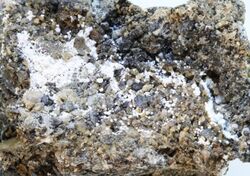Chemistry:Felsőbányaite
| Felsőbányaite | |
|---|---|
 Felsöbanyaite as white spherules. Roadcut near Sant Marti dels Castells (Lérida) Spain | |
| General | |
| Category | Sulfate mineral |
| Formula (repeating unit) | Al4(SO4)(OH)10·4H2O |
| Strunz classification | 7.DD.05 |
| Crystal system | Monoclinic |
| Crystal class | Sphenoidal (2) (same H-M symbol) |
| Space group | P21 |
| Unit cell | a = 13.026 Å, b = 10.015 Å, c = 11.115 Å; β = 104.34°; Z = 4 |
| Identification | |
| Color | White to pale yellow, pale brown |
| Crystal habit | Globular masses, minute rhombic crystals |
| Cleavage | Distinct to good on {010} and {100} |
| Mohs scale hardness | 1.5 |
| |re|er}} | Vitreous, pearly on cleavage surfaces |
| Diaphaneity | Semitransparent |
| Specific gravity | 2.33 |
| Optical properties | Biaxial (+) |
| Refractive index | n = 1.515–1.540 |
| References | [1][2] |
Felsőbányaite or basaluminite is a hydrated aluminium sulfate mineral with formula: Al4(SO4)(OH)10·4H2O. It is a rare white to pale yellow mineral which typically occurs as globular masses and incrustations or as minute rhombic crystals. It crystallizes in the monoclinic crystal system.[2][1]
It occurs as a weathering product under acidic conditions associated with pyrite or marcasite decomposition. Associated minerals include hydrobasaluminite, hydroargillite, meta-aluminite, allophane, gibbsite, gypsum and aragonite.[2]
Felsőbányaite was first described in 1853 for an occurrence in the Baia Sprie mine, Baia Sprie (Felsőbánya), Maramureș County, Romania, and named for the locality.[1] The mineral name basaluminite was used for an occurrence of the same mineral in England in 1948 and discredited by the International Mineralogical Association (IMA) in 2006.[4]
References
- ↑ 1.0 1.1 1.2 Felsőbányaite on Mindat.org
- ↑ 2.0 2.1 2.2 Basaluminite in the Handbook of Mineralogy
- ↑ Warr, L.N. (2021). "IMA–CNMNC approved mineral symbols". Mineralogical Magazine 85 (3): 291–320. doi:10.1180/mgm.2021.43. Bibcode: 2021MinM...85..291W.
- ↑ "Burke, E. A. (2006) A mass discreditation of GQN minerals, The Canadian Mineralogist, 44(6), pp. 1557-1560". http://pubsites.uws.edu.au/ima-cnmnc/GQNminerals.pdf.
 |

